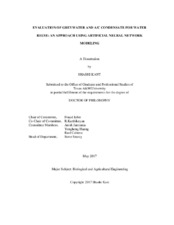| dc.description.abstract | Alternative resources play a vital role for water-sensitive infrastructures where consistent water supply is a challenge, and freshwater resources are limited. Greywater and A/C condensate are potentially new alternatives for increasing urban water supply. An advanced physical filtration system for greywater treatment was developed named as GAC-MI-ME. It is comprised coarse filtration (CR-F) followed by microfiltration (MF), granular activated carbon (GAC), ultrafiltration (UF), ultraviolet (UV), and reverse-osmosis (RO). GAC-MI-ME effluent-quality was analyzed for greywater from laundry, shower, and wash basin. High-grade effluent equivalent to unrestricted water reuse was observed at UF and RO units. A subsequent tool (GREY-ANN) was proposed for GAC-MI-ME effluent quality predictions. Artificial Neural Network (ANN) was applied to develop 5 unit models for selected parameters including Biochemical Oxidation Demand, pH, Total Dissolved Solids, Turbidity, and Oxidation-Reduction Potential to predict effluent quality at each stage of GAC-ME-MI treatment using water quality databases (developed from a series of experiments testing greywater of varying strength). The 15 days storage potential of GAC-MI-ME treated effluents were also analyzed and showed no significant quality depletion in UF and RO effluent quality.
A hybrid modeling approach was applied to A/C condensate estimation, which included a psychrometric based “Air-Conditioner-Condensate” (ACON) model, and data-driven “Internal Load Analysis using Neural Network” (ILAN) model. The ACON model uses mass and energy balance approach for HVAC systems operating under steady state conditions. It accounts for psychometric states of different air parcels during the cooling and dehumidification process. The ILAN model was developed using ANN for the city of Doha to predict Internal Load at a daily time step for variable climatic conditions (temperature, relative humidity). The ACON- ILAN models were validated for a test building and applied for yearly condensate estimation for Doha. The virtual simulations of the hybrid model showed an annual condensate volume of 1370 and 3700 l/100 m^3 of cooling space for 20% and 100% outdoor-ventilation. The condensate quality (for limited water quality parameters) showed values within primary and secondary drinking water standards, except for copper, which had marginally higher concentrations. Overall, the GREY-ANN and ACON-ILAN may improve greywater and A/C condensate reuse potentials. | en |


